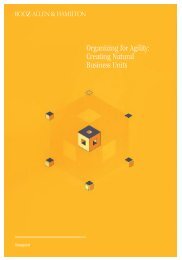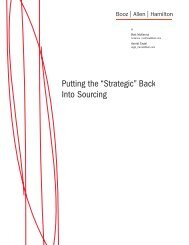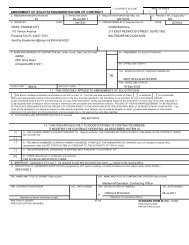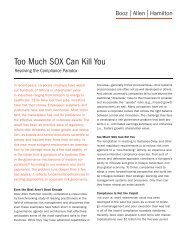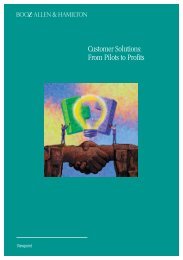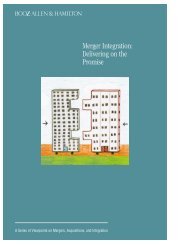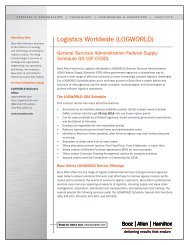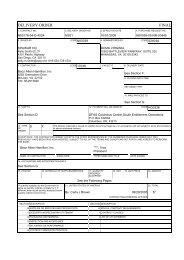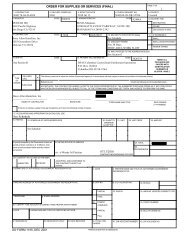Building the Enterprise - Booz Allen Hamilton
Building the Enterprise - Booz Allen Hamilton
Building the Enterprise - Booz Allen Hamilton
- No tags were found...
You also want an ePaper? Increase the reach of your titles
YUMPU automatically turns print PDFs into web optimized ePapers that Google loves.
cross-cutting mission areas. Theyalso occur with mission-supportfunctions, such as purchasing goodsand services and cutting payrollchecks. Suboptimal performance,duplication of effort, inefficiencyand wasted resources are <strong>the</strong> result.For example, agencies regularlypay too much for commodity purchasesbecause <strong>the</strong>y fail to leverage<strong>the</strong> combined buying power of <strong>the</strong>federal enterprise. Thus, while manyagencies, such as <strong>the</strong> Department ofCommerce, have consolidated IThardware and software purchaseswithin <strong>the</strong>ir own ranks to save millionsof dollars, this same approachapplied across government couldsave hundreds of millions of dollars.Needless duplication and overlapalso abound in <strong>the</strong> government’shandling of security clearance backgroundinvestigations to determinesuitability for federal hiring. Multipleagencies have made separateand costly investments in electroniccase management and adjudicationsystems for background investigationsinstead of working toge<strong>the</strong>r tocreate and use a shared system, accordingto <strong>the</strong> GAO. 3The president and <strong>the</strong> executivebranch must redouble <strong>the</strong>ir effortsto take a more holistic, enterpriseapproach to <strong>the</strong> multiagency missionsand functions of government.When we say that <strong>the</strong> federal governmentshould act more like an enterprise,we mean that it should betterintegrate and unify <strong>the</strong> efforts of<strong>the</strong> executive departments, agencies,bureaus and offices to achieve crosscuttinggoals, missions and functionsthat individual agencies cannot effectivelytackle on <strong>the</strong>ir own.While fully recognizing thatmany challenges require <strong>the</strong> participationof state, county and localgovernments as well as private organizationsand institutions and internationalpartners, we have chosen tolimit <strong>the</strong> boundaries of this report to3 Ibid. 79–83.“When we say that <strong>the</strong> federalgovernment should act morelike an enterprise, we meanthat it should better integrateand unify <strong>the</strong> efforts of <strong>the</strong>executive departments,agencies, bureaus and officesto achieve cross-cutting goals,missions and functions thatindividual agencies cannoteffectively tackle on <strong>the</strong>ir own.”focus specifically on <strong>the</strong> operation of<strong>the</strong> executive branch of <strong>the</strong> federalgovernment. However, <strong>the</strong> enterpriseapproach we advocate is justas necessary in tackling intergovernmentaland international challenges,and just as applicable.Taking <strong>the</strong> enterprise approachdoes not mean that government missionsand functions must be centralized.That approach has its ownset of bureaucratic problems. Norare we suggesting that current departmentaland agency missions beeliminated or that government bemassively reorganized. History hasshown that restructuring governmentis a politically charged, expensiveand time-consuming processthat often has unintended consequences.It typically fails to attack<strong>the</strong> root causes of a particular issueand, most importantly, diverts attentionfrom solving problems thatnow mutate faster than any reorganizationcan match. We need an approachthat is as adaptive and flexibleas <strong>the</strong> challenges it is designedto overcome.The enterprise model describedthroughout this roadmap meets thisobjective. Unlike past managementreforms, it minimizes <strong>the</strong> need forlegislation or wholesale restructuring.However, it does require morethan interagency committees, councilsand task forces—<strong>the</strong> traditionalapproach when agencies are forcedto work toge<strong>the</strong>r. It will require culturechange and commitment by seniorleaders, as well as investment inmanagement infrastructure.The president and <strong>the</strong> executivebranch can employ this new modelto address national public policygoals and cross-cutting federal missions,such as securing our nationand its borders, protecting our interestsabroad, ensuring food safety,sustaining economic growth and development,assuring a well-trainedand educated workforce, fosteringpublic health, facilitating internationaltrade and delivering social4 PARTNERSHIP FOR PUBLIC SERVICE | BOOZ ALLEN HAMILTON




